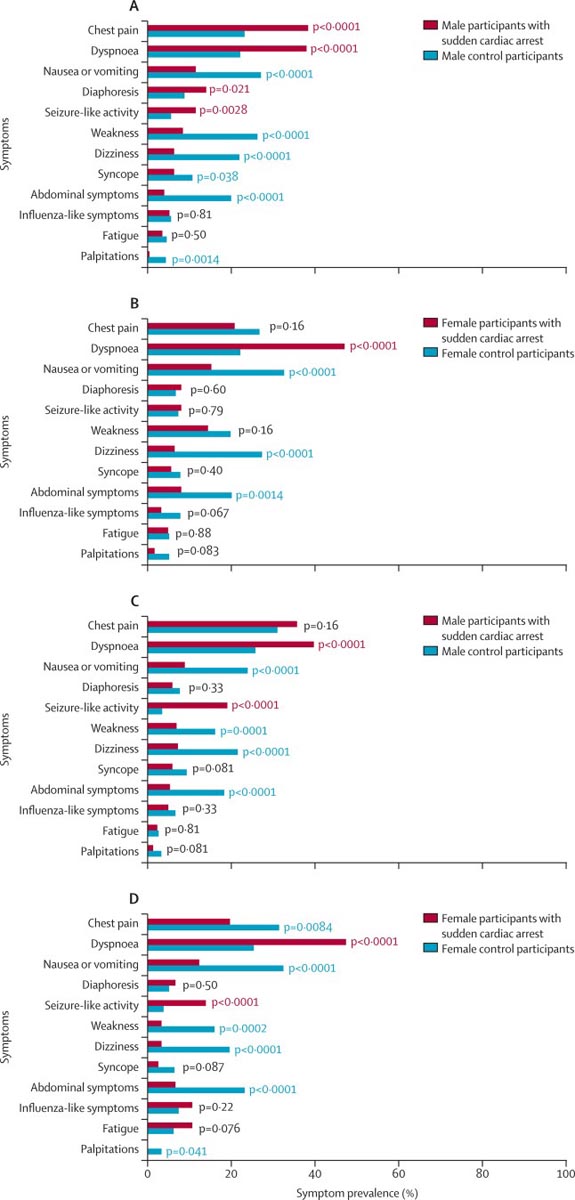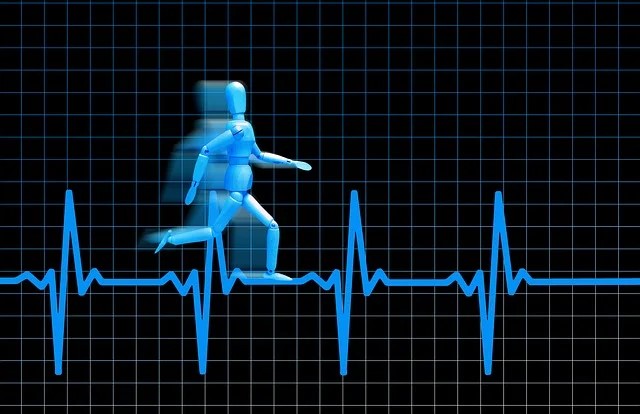Summary: Researchers are one step closer to helping people detect sudden cardiac arrest before it happens, thanks to a new study. The study, led by sudden cardiac arrest experts, found that 50% of people who experienced sudden cardiac arrest also experienced a telltale symptom 24 hours before the loss of heart function. |
Background
Sudden cardiac arrest is a global public health problem with a mortality rate of over 90%. Pre-arrest warning symptoms could be leveraged through digital technology to potentially improve survival outcomes. Our objective was to estimate the strength of the association between symptoms and impending sudden cardiac arrest.
Methods
We conducted a case-control study of individuals with sudden cardiac arrest and participants without sudden cardiac arrest who had similar symptoms identified in two US community studies of patients with sudden cardiac arrest in the state of California, USA and the state of Oregon, USA. Participant data were obtained from emergency medical services reports of people between 18 and 85 years of age who witnessed sudden cardiac arrest (between February 1, 2015 and February 31, 2015). January 2021) and a symptom of inclusion.
Data were also obtained from corresponding control populations without sudden cardiac arrest who were treated by emergency medical services for similar symptoms (between January 1 and December 31, 2019). We evaluated the association of symptoms with sudden cardiac arrest in the discovery population and validated our results in the replication population using logistic regression models.
Results
We identified 1672 people with sudden cardiac arrest from the PRESTO study, of whom 411 patients (mean age 65.7 [SD 12.4] years; 125 women and 286 men) were included in the discovery population analysis. Of a total of 76,734 calls to emergency medical services, 1,171 patients (mean age 61.8 [SD 17.3] years; 643 women, 514 men, and 14 participants without gender data) were included in the control group.
Patients with sudden cardiac arrest were more likely to have dyspnea (168 [41%] of 411 vs 262 [22%] of 1,171; p<0.0001), chest pain (136 [33%] vs 296 [25%]; p=0·0022), diaphoresis (50 [12%] vs 90 [8%]; p=0·0059), and seizure-like activity (43 [11%] vs 77 [7%], p=0·011).
The frequencies and patterns of symptoms differed significantly by sex . Among men , chest pain (odds ratio [OR] 2.2, 95% CI 1.6–3.0), dyspnea (2.2, 1.6–3.0), and diaphoresis (1. 7, 1 ·1–2.7) were significantly associated with sudden cardiac arrest, while among women , only dyspnea was significantly associated with sudden cardiac arrest (2.9, 1.9–4.3).
427 patients with sudden cardiac arrest (mean age 62.2 [SD 13.5]; 122 women and 305 men) were included in the analysis for the replication population and 1238 patients (mean age 59.3 [16.5] years ; 689 women, 548 men, and one participant with missing sex data) were included in the control group.
The findings were largely consistent in the replication population; However, notable differences included that, among men, diaphoresis was not associated with sudden cardiac arrest and chest pain was associated with sudden cardiac arrest only in multivariable analysis stratified by sex.

Figure: Frequency of symptoms in participants with at least one predefined symptom. Frequency of symptoms in male participants with sudden cardiac arrest (n = 286) and controls (n = 514) in the PRESTO discovery population (A), female participants with sudden cardiac arrest (n = 125) and controls (n = 657) in the PRESTO Discovery Population (B), male participants with sudden cardiac arrest (n=305) and controls (n=548) in the SUDS replication population (C), and female participants (n=122) and controls (n =690) in the SUDS replication population (D). Sex data were missing for 14 control participants in the PRESTO discovery population and one control participant in the SUDS replication population.
Interpretation The prevalence of warning symptoms was sex-specific and differed significantly between patients with sudden cardiac arrest and controls. Warning symptoms show promise for predicting imminent sudden cardiac arrest, but may need to be augmented with additional features to maximize predictive power. |
Comments
Smidt Heart Institute researchers found that 50% of people experienced warning signs before their cardiac arrest.
Researchers at the Smidt Heart Institute at Cedars-Sinai are one step closer to helping people detect sudden cardiac arrest before it happens, thanks to a study published in the peer-reviewed journal Lancet Digital Health .
The study, led by sudden cardiac arrest expert Sumeet Chugh, MD, found that 50% of people who experienced sudden cardiac arrest also experienced a telltale symptom 24 hours before the loss of cardiac function.
Researchers at the Smidt Heart Institute also found that this warning symptom was different for women than for men . For women, the most prominent symptom of impending sudden cardiac arrest was difficulty breathing, while men experienced chest pain.
Smaller subgroups of both sexes experienced palpitations, seizure-like activity, and flu-like symptoms.
Out-of-hospital sudden cardiac arrest claims the lives of 90% of people who experience it, marking an urgent need to better predict (and prevent) the condition.
"Taking advantage of warning symptoms to effectively triage those who need to make a 911 call could lead to early intervention and prevention of imminent death," said Chugh, director of the Cardiac Arrest Prevention Center at Smidt Heart. Institute and lead author of the study. "Our findings could lead to a new paradigm for the prevention of sudden cardiac death."
For this study, researchers used two established and ongoing community studies, each developed by Chugh: the ongoing Predicting Sudden Death in Multiethnic Communities (PRESTO) study in Ventura County, California, and the Sudden Death Study and Unexpected (SUDS), based in Portland, Oregon.
Both studies provide Cedars-Sinai researchers with unique community-based data to establish how to best predict sudden cardiac arrest.
"It takes a village to do this work," said Chugh, the Pauline and Harold Price Research Professor in Cardiac Electrophysiology, medical director of the Heart Rhythm Center in the Department of Cardiology and director of the Division of Artificial Intelligence in Medicine in the Department of Cardiology. Medicine. "We began the SUDS study 22 years ago and the PRESTO study eight years ago. These cohorts have provided invaluable lessons along the way. Importantly, none of this work would have been possible without the partnership and support of first responders, medical examiners and the hospital systems that provide care within these communities.
In the Ventura and Oregon studies, Smidt Heart Institute researchers assessed the prevalence of individual symptoms and symptom clusters before sudden cardiac arrest and then compared these findings to control groups who also sought emergency medical care.
The Ventura study showed that 50% of 823 people who suffered sudden cardiac arrest witnessed by a bystander or an emergency medicine professional, such as an emergency medicine service (EMS) first responder, experienced at least one symptom developer 24 hours before. The study conducted in Oregon showed similar results.
"This is the first community-based study to evaluate the association of warning symptoms (or clusters of symptoms) with impending sudden cardiac arrest using a comparison group with EMS-documented symptoms recorded as part of routine emergency care," said Eduardo Marbán. , MD, PhD, executive director of the Smidt Heart Institute and Mark Siegel Family Foundation Distinguished Professor.
Such a study, Marbán says, paves the way for additional prospective studies that will combine all symptoms with other characteristics to improve the prediction of imminent sudden cardiac arrest.
"Next, we will complement these key sex-specific warning symptoms with additional features, such as clinical profiles and biometric measures, to improve the prediction of sudden cardiac arrest," Chugh said.
















